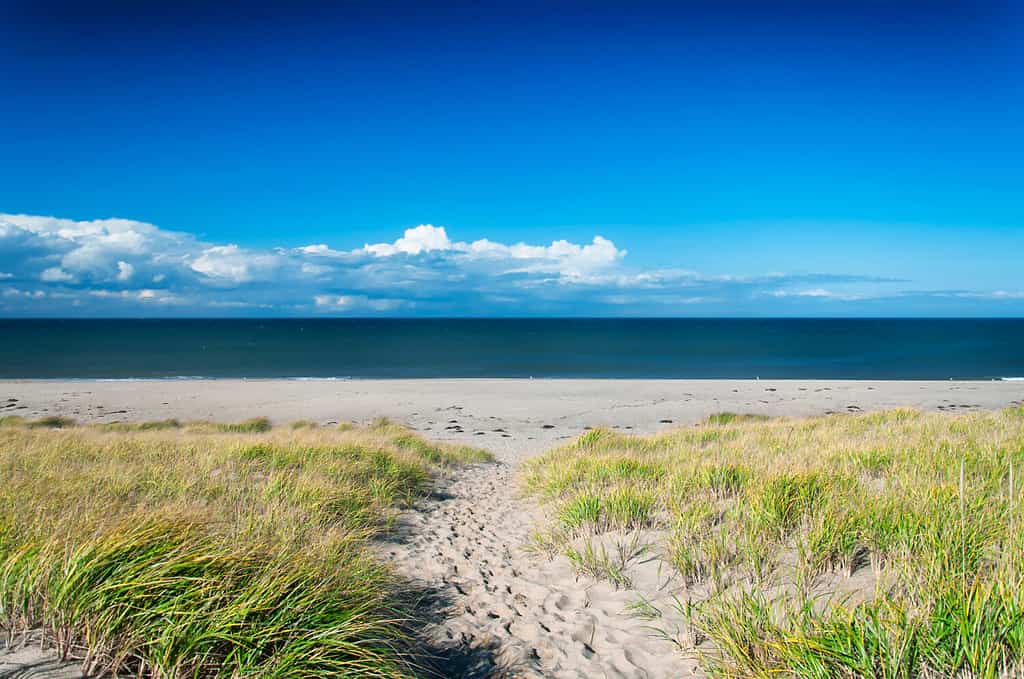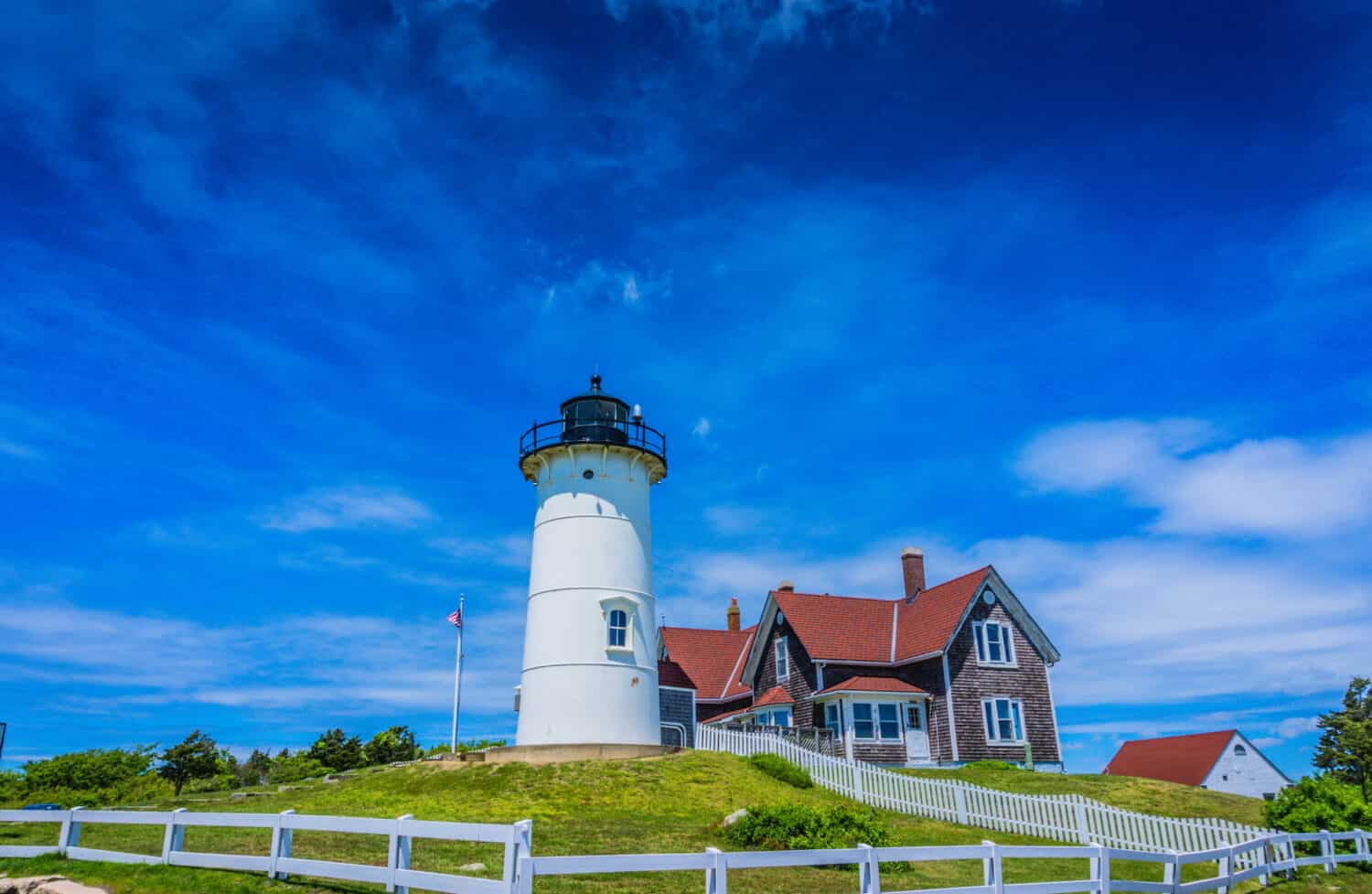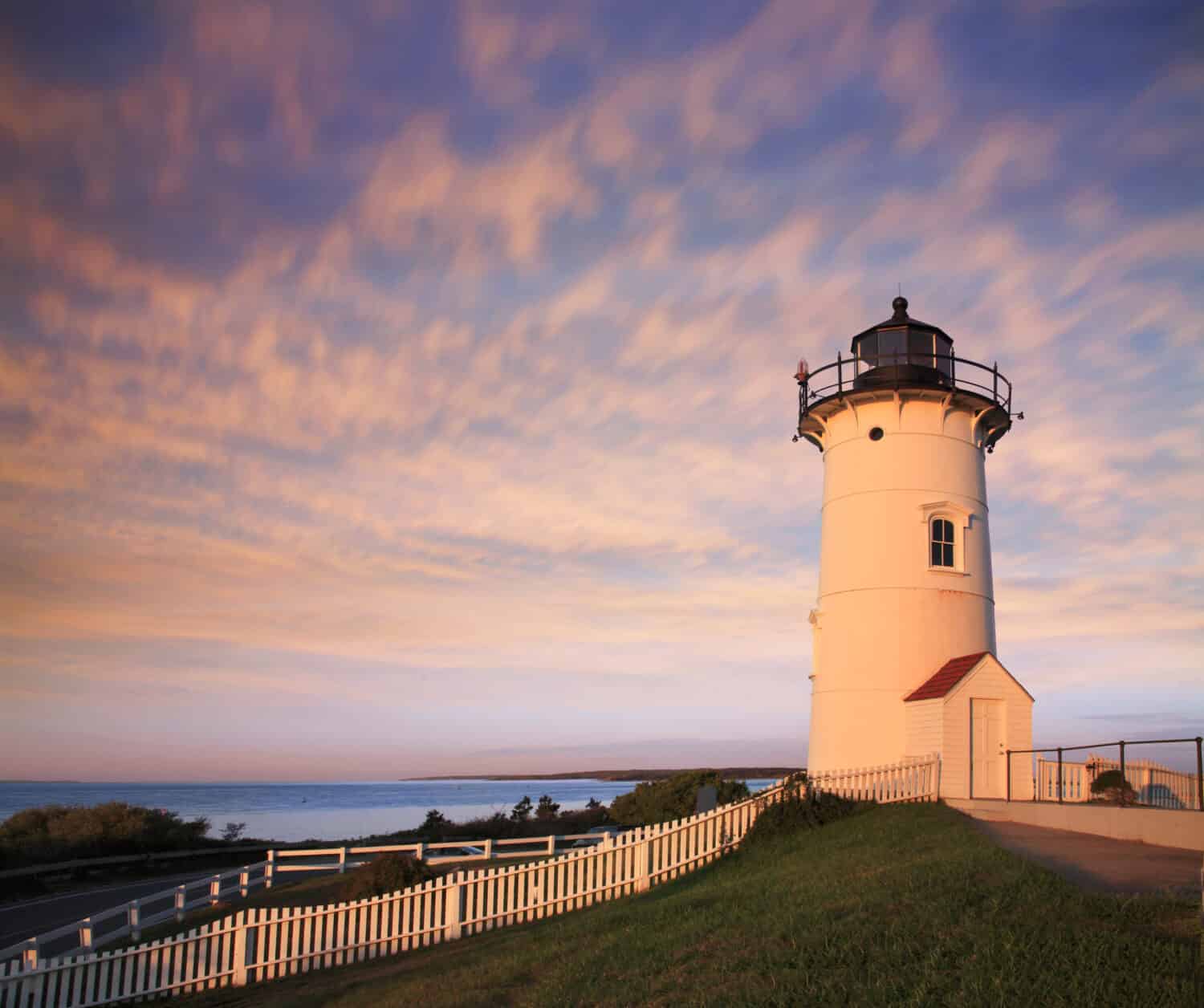In 1961, then-president John F. Kennedy founded the Cape Cod National Seashore along the coast of the U.S. state of Massachusetts. It contains a wide variety of natural habitats, everything from sprawling beaches to uplands, wetlands, marshes, and forests. As a result, recreation of all kinds is accessible at Cape Cod, whether you want to hunt and hike or take it easy just swimming in the Atlantic Ocean or biking alongside it.
Among the many tourist attractions — which include shipwrecks, birdwatching, and more — the lighthouses of Cape Cod remain a heavy pull for visitors both in and out of state. Read on to discover the five most beautiful lighthouses that the Cape Cod National Seashore has to offer!

There are over 200 miles of coastline where the Atlantic Ocean meets the land at Cape Cod.
©Dan Hanscom/Shutterstock.com
1. Chatham Lighthouse
The Chatham Lighthouse was first built in the southeastern section of Cape Cod. Over time, there have been six total versions of the lighthouse constructed. The original Chatham Lighthouse was erected in 1808. In addition to being the second lighthouse in Cape Cod, its two towers lasted over thirty years until they were rebuilt in 1841 on a budget of $6,750.
These towers were built roughly seventy feet apart in an effort to help bring ships closely through the coastline. That was no easy task as this area became responsible for over three thousand shipwrecks from 1850 to 1980. They were nicknamed “The Twin Lights”, and many still refer to them by this moniker today.
Years of constant erosion took their toll on the land around the lighthouse. By 1877 it was necessary to again rebuild the towers to ensure posterity and moved inland to avoid close contact with the rapidly receding shoreline. By 1923, rotating lights became a standard feature of lighthouses. Because it was no longer necessary to have two so close together one of the towers was moved to Eastham and dubbed “The Nauset Light.”
In 1939 the United States Coast Guard assumed command of the Chatham Lighthouse. It continued to keep it functioning for the duration of the Second World War. During this period the lighthouse received motorized functionality and an electric light.
In 1982 the lighthouse was fully automated. The Chatham Lighthouse remains an active post for the United States Coast Guard to this day. It is open to visitors via guided tour during the summer months and is a popular tourist attraction for all those visiting Chatham.

The Chatham Lighthouse in Cape Cod, Massachusetts.
©Exploring and Living/Shutterstock.com
2. Nauset Lighthouse
The Nauset Lighthouse is one of Cape Cod’s most beloved lighthouses. It has become famous as the lighthouse on the bag for the Cape Cod Potato Chips company. It is probably one of the tower that Edward Hopper depicted in his famous series of lighthouse paintings.
“The Three Sisters”
Before there was one Nauset Lighthouse in Eastham, there were three towers nicknamed “The Three Sisters.” They were constructed in 1838, each fifteen feet high, and officially referred to as the Nauset Beach Light Station. In 1892 they were interchanged with new towers now standing 22 feet tall and placed significantly farther in from the encroaching coast.
By 1911, erosion in Cape Cod made it essential to move the three lighthouse towers once more. “The Three Sisters” were split up. Two were sold at an auction. The remaining tower was given an adjoining lighthouse keeper’s quarters and reinforced with a brick base and a spinning Fresnel Lens.
The Last Tower
In 1923, this last tower was condemned. A lighthouse originally built in 1877 in Chatham was moved to Eastham and became the new Nauset Lighthouse. This tower is part of the National Register of Historic Places. It received its now iconic red and white paint job in 1940 to make it easily identifiable during daylight hours.
The United States Coast Guard helped automate the tower in 1955, and the keeper’s dwelling was sold as a result. By the 1980s, more than a hundred years after its initial construction, the lighthouse again needed to be moved due to erosion concerns.
The Nauset Light Preservation Society helped raise the funds necessary to move the lighthouse back 336 feet. This was accomplished in 1996. It required two full days of labor before the tower once again stood at a safe distance from the cliffside.
In 1998 the original lighthouse keepers’ quarters were donated back to the Nauset Lighthouse grounds. Free tours of the grounds and the tower are available year-round, usually on Sundays or Wednesdays.

The Nauset Lighthouse with a beautiful Cape Cod sunset.
©Shanshan0312/Shutterstock.com
3. Monomoy Point Light Station
Monomoy Point is located right where the Atlantic Ocean meets the Nantucket Sound. This creates powerful currents in shallow waters that have caused many shipwrecks over the centuries. In the early days of American settlement, the French nicknamed Monomoy Point “Cape Malabar.” This phrase translates to the “Cape of Evil Bars” because of its proliferation of sand bars.
Initial Construction
The Monomoy Point Light Station was built in 1823 for $2782.72. It is one of the first American lighthouses to be constructed with cast iron, the other two being the Juniper Island Lighthouse in Vermont and the Long Island Head in Boston. It is situated on the lowest end of Monomoy Island. This area has since been split into two distinct land masses by a blizzard in 1978. The original Lighthouse was paired with a keeper’s quarters made from iron, brick, and wood. It was in continuous operation for a quarter of a century before it needed to be torn down and rebuilt.
In 1849, a new forty-foot-tall tower was constructed. By the following decade, the Monomoy Point Light Station was the recipient of a fourth-order Fresnel lens. In 1882, the tower was painted in its now distinctive red hue. Ten years later, the structure was reinforced with iron trusses.
Further Developments
The Cape Cod Canal’s 1914 debut coincided with the upgrading of the Chatham Tower’s light. This had the effect of further decreasing the need for multiple lighthouses in the area. By 1923, the Monomoy Point Light Station was deactivated and sold to a private citizen until 1944. At that point, the Eastern Massachusetts National Wildlife Refuge Complex bought Monomoy Island and turned it into a national wildlife refuge.
Eventually, the Monomoy Point Light Station was restored to a better working condition. It is now a tourist center for the many programs offered to tourists visiting Monomoy National Wildlife Refuge. The island is not inhabited by humans and is only accessible via boat, so come prepared when visiting this historical tower and keeper’s dwellings. Those wishing to visit can cross via the Monomoy Island Ferry.

4. Nobska Point Lighthouse
Initially named the “Nobsque Light” and today known as the “Nobska Point Lighthouse,” this Cape Cod tower sits right at the confluence of the Nantucket Sound, the Vinyard Sound, and Buzzards Bay in Woods Hole, Massachusetts.
Initial Construction
The Nobska Point Lighthouse was constructed for $2949.30 in 1828. Upon completion, the tower stood seventy-eight feet high and was attached to a lighthouse keeper’s quarters built from stone. Unfortunately, the design of the lighthouse was not properly thought out. Multiple leaks and structural stresses prompted the Lighthouse Board to request a rebuild by 1875.
The following year a new Nobska Point Lighthouse tower and quarters were built. The facility featured a forty-foot tower made from cast iron and brick, and a lighthouse keeper’s quarters constructed with wood. This structure is still standing today. The fifth-order Fresnel lens that was originally installed in 1856 was removed and replaced with a fourth-order Fresnel lens in 1888.
Further Developments
In 1905, the first structure saw the annection of another lighthouse keeper’s quarters. In 1937 the lighthouse received a state-of-the-art radio beacon tower and fog signal that stood one-hundred-twenty-five feet tall above the grounds. Joseph Hindley, the tower’s final lighthouse keeper, retired in November 1972. He was the last non-military lighthouse keeper in New England.
By 1985 the Nobska Point Lighthouse was fully automated. The United States Coast Guard assumed responsibility for its upkeep. The former keeper’s dwellings became the official residence of the Coast Guard Commander for South East New England. Two years later, the National Register of Historic Places accepted the Nobska Point Lighthouse into its ranks.
In 2017 the nearby town of Falmouth assumed control of the lighthouse in conjunction with the Friends of Nobska Light. Today more than ten thousand tourists a year visit the lighthouse. The keeper’s dwelling has been converted into a maritime museum.

The Nobska Point Lighthouse at dusk.
©Doug Lemke/Shutterstock.com
5. Highland Light Station
Though this tower is officially known as the “Cape Cod Lighthouse,” it is most often referred to as the “Highland Light” or the “Highland Light Station.” George Washington himself called for the construction of the Highland Light Station. For European immigrants arriving at Massachusetts Bay for the first time, this lighthouse and its beam were often the first things they saw upon arrival in the New World.
It was not only the seventh lighthouse built by the government but also the twentieth lighthouse ever to be built in the United States of America. Congress approved the build on May 17th, 1796, and appropriated $8000 for it to be constructed on what is now the Cape Cod National Seashore in North Truro.
Initial Construction
The initial grounds contained a tower made from wood that stood 45 feet tall, as well as a lighthouse keeper’s quarters. Both were situated about 500 feet from the cliffside. However, by 1831, they were in such a state of disrepair that it necessitated a new structure.
A sixty-six feet tall tower, a new keeper’s dwelling, and a generator shed were completed in 1857. There was also a shielded walkway that connected the tower to the keeper’s quarters.
A first-order Fresnel lens was installed at the turn of the century, on June 6th, 1900. It cost the United States Congress a total of $15,000 to finish and remained in operation until 1946, when a state-of-the-art aerobeacon replaced it.
Further Developments
The Highland Light Station was automated in 1987. The aerobeacon was then replaced with a rotating light to achieve maximum visibility and transmission of the beacon.
Over the century, steady erosion posed a consistent threat to the stability of the Highland Light Station. By 1996 it became necessary to fundraise $1.5 million dollars to move the structure. It was repositioned by the International Chimney Corp and Expert House Moving company, who worked in conjunction to place the Highland Light back another 453 feet from the cliffside.
In 1998 the non-profit Highland Museum and Lighthouse partnered with the National Park Service to create a gift shop in the former lighthouse keeper’s quarters and provide tours of the tower for visitors. In January 2014, Eastern National succeeded the non-profit and okayed the construction of a nearby golf course.
Tours are offered every fifteen minutes, and guides are stationed at the top and bottom of the lighthouse to offer history and insight to travelers visiting the Highland Light Station.

The Highland Light, also known as the Cape Cod Light, is the oldest and tallest lighthouse on Cape Cod.
©James Kirkikis/Shutterstock.com
The photo featured at the top of this post is © Shanshan0312/Shutterstock.com
Thank you for reading! Have some feedback for us? Contact the AZ Animals editorial team.







